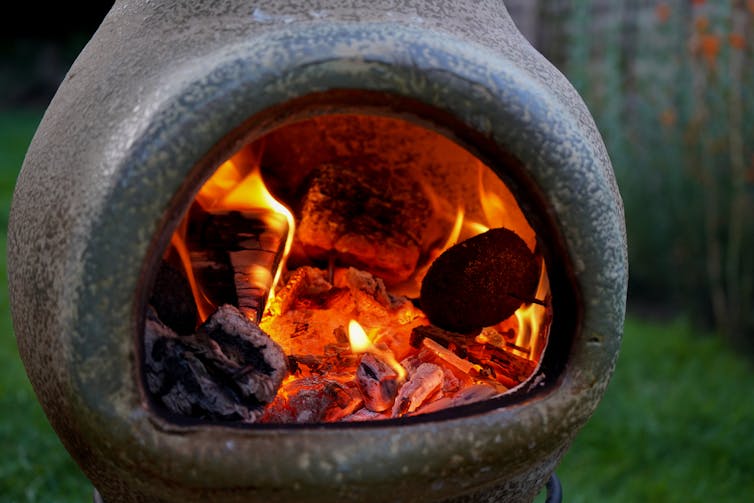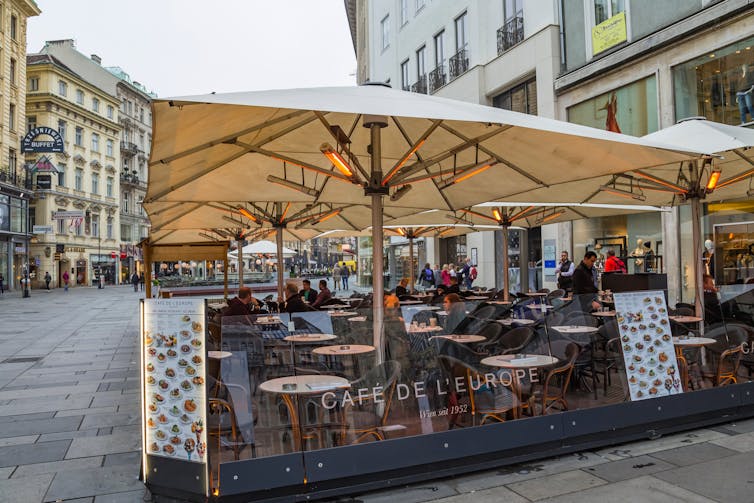
Sharon George, Keele University
Over the summer, eating outdoors was a pleasant way to socialise more safely at pubs, restaurants and in gardens. But as temperatures drop and covid restrictions remain in place, socialising outdoors becomes more tricky (even after lockdown).
Regular patio heaters are hugely inefficient for use outdoors since so much of the heat they generate is simply lost as there are no walls and ceilings to hold it in. So how can we keep everyone warm outside – without generating a huge carbon footprint?
The simplest outdoor heating option is a firepit or a log burner. These are widely popular but can significantly add to air pollution. How much heat is produced can also vary depending on how concentrated the energy is in the fuel and, for wood fires, how much water is in the wood.
Dried wood only has a calorific value (a measure of how much heat it will emit) of around 15 megajoules (MJ) per kg, whereas lightweight, cleaner-burning charcoal has an efficiency of around 30 MJ per kg, which is better than coal at 25 MJ per kg. Yes, an efficient outdoor woodburning stove will help the fuel burn hotter, and produce less emissions, but these can be expensive and the performance will vary with the quality and dryness of the wood.

Even if we ignore the cost and the carbon emissions, we’re still left with the problem that wood, coal and charcoal all produce lots of dust particles. The World Health Organisation estimates that around 7 million premature deaths each year can be linked to particulates. The fumes from wood burners are particularly hazardous and they are a major contributor to poor air quality. Burning wood on an open fire produces more of these harmful particulates than burning coal. The wetter the wood the more smoke is produced.
Patio heaters can take the chill off the air temperature thanks to their warm glow coupled with a pleasant warming effect. However they are highly controversial as they mainly run on fossil fuels and, as their heat is largely dissipated, they are an extravagant use of these carbon-rich fuels. While a patio heater warms you, it is also warming up the air and area around you – ultimately wasting energy.
A typical gas-powered patio heater warming your table during a night out for just a couple of hours, might use up a huge 108 MJ and emit 3 kg CO2. An equivalent, more efficient electric system would only use one-fifth of that energy, would be cheaper to run, and during the same evening would produce less than a kg of carbon dioxide.
There are greener alternatives, such as heaters that run on biogas or bioethanol from waste which burn cleanly and do not rely on fossil fuels, but this is still a very inefficient use of energy.
Unlike other heaters that warm the air around us, infrared heaters work by “shining” infrared radiation directly at its target. This is more efficient in an outdoor setting and the effect is instant as soon as the heater comes on. So far so good.

The problem is that infrared heaters only heat whatever is in the path of radiation, like a hot torch. Anything not in the beam, or in a shadow, stays cold. This means that your arms, face and body may feel comfortable but your legs and feet under the table could still feel chilly. This will be exacerbated the colder we are as blood flow to our extremities is reduced, making our feet colder still.
Thermal comfort is about more than just the heat. We don’t need to blast the fuel to make us feel warm. We could use an efficient infrared heater coupled with other tweaks to improve our satisfaction with the temperature in our surroundings overall.
To feel warmer you need to create the right ambience and reduce draughts that remove the warm layer of air immediately next to the skin. Lighting can help, as it turns out our perception of how cold we are is affected by daylight. Warming up those cold feet can also have an outsized impact on satisfaction, as we experience pleasure when a cold part of our body is warmed up, a process called spatial alliesthesia. Providing under-table heaters or even foot warmers on a cold day would provide that pleasurable cosy relief and make us feel less cold.
At any other time, if someone asked me how to keep warm outdoors my advice as an environmental scientist would be to wrap up with extra layers or simply stay indoors. But these are not normal times, and this winter people will want to spend time outdoors and socialise in fresh air. On a tight carbon budget, this will mean an infrared heater.![]()
Sharon George, Senior Lecturer in Environmental Science, Keele University
This article is republished from The Conversation under a Creative Commons license. Read the original article.
Contact us
Andy Cain,
Media Relations Manager
+44 1782 733857
Abby Swift,
Senior Communications Officer
+44 1782 734925
Adam Blakeman,
Press Officer
+44 7775 033274
Ashleigh Williams,
Senior Internal Communications Officer
Strategic Communications and Brand news@keele.ac.uk.
